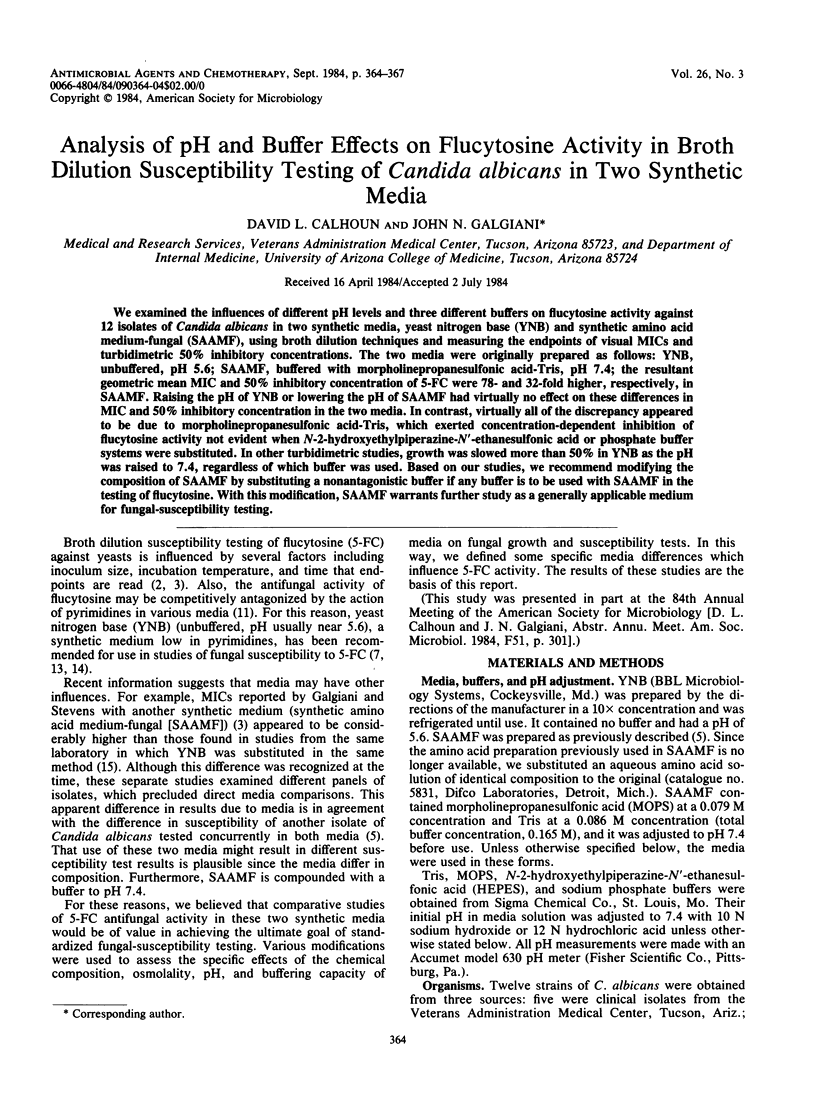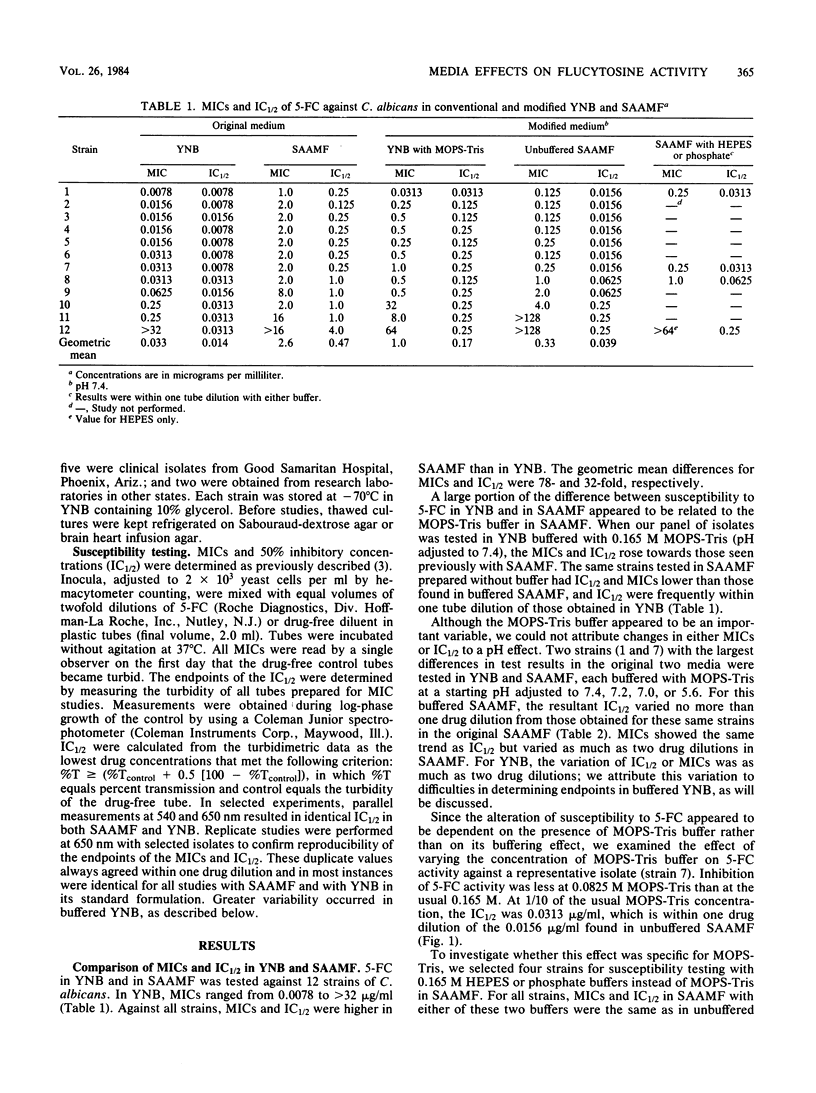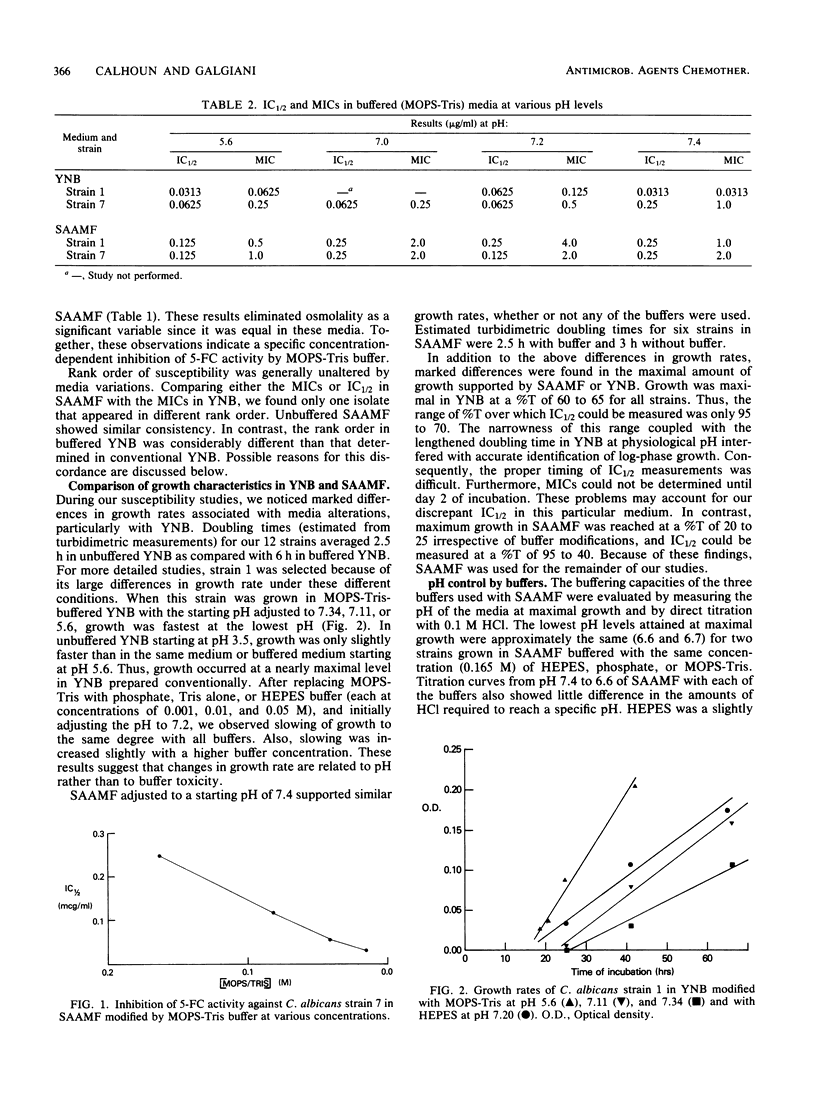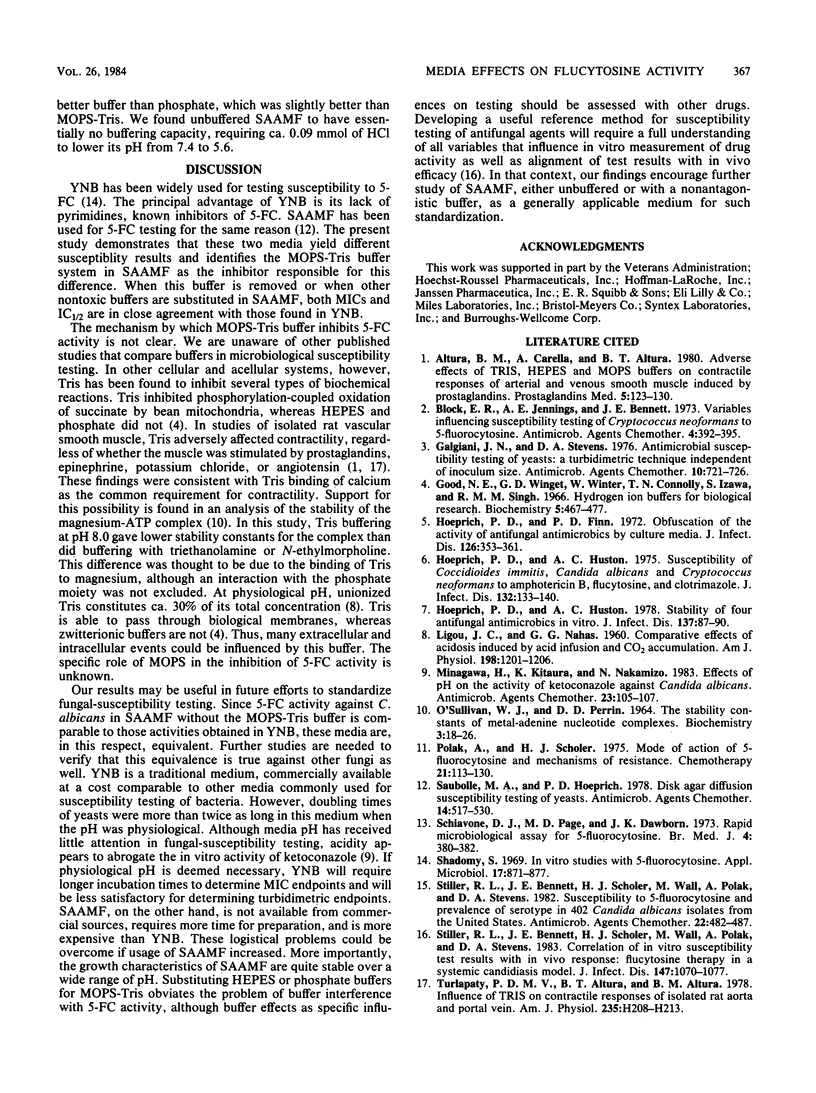Abstract
We examined the influences of different pH levels and three different buffers on flucytosine activity against 12 isolates of Candida albicans in two synthetic media, yeast nitrogen base (YNB) and synthetic amino acid medium-fungal (SAAMF), using broth dilution techniques and measuring the endpoints of visual MICs and turbidimetric 50% inhibitory concentrations. The two media were originally prepared as follows: YNB, unbuffered, pH 5.6; SAAMF, buffered with morpholinepropanesulfonic acid-Tris, pH 7.4; the resultant geometric mean MIC and 50% inhibitory concentration of 5-FC were 78- and 32-fold higher, respectively, in SAAMF. Raising the pH of YNB or lowering the pH of SAAMF had virtually no effect on these differences in MIC and 50% inhibitory concentration in the two media. In contrast, virtually all of the discrepancy appeared to be due to morpholinepropanesulfonic acid-Tris, which exerted concentration-dependent inhibition of flucytosine activity not evident when N-2-hydroxyethylpiperazine-N'-ethanesulfonic acid or phosphate buffer systems were substituted. In other turbidimetric studies, growth was slowed more than 50% in YNB as the pH was raised to 7.4, regardless of which buffer was used. Based on our studies, we recommend modifying the composition of SAAMF by substituting a nonantagonistic buffer if any buffer is to be used with SAAMF in the testing of flucytosine. With this modification, SAAMF warrants further study as a generally applicable medium for fungal-susceptibility testing.
Full text
PDF



Selected References
These references are in PubMed. This may not be the complete list of references from this article.
- Altura B. M., Carella A., Altura B. T. Adverse effects of Tris. HEPES and MOPS buffers on contractile responses of arterial and venous smooth muscle induced by prostaglandins. Prostaglandins Med. 1980 Aug;5(2):123–130. doi: 10.1016/0161-4630(80)90099-3. [DOI] [PubMed] [Google Scholar]
- Block E. R., Jennings A. E., Bennett J. E. Variables influencing susceptibility testing of Cryptococcus neoformans to 5-fluorocytosine. Antimicrob Agents Chemother. 1973 Oct;4(4):392–395. doi: 10.1128/aac.4.4.392. [DOI] [PMC free article] [PubMed] [Google Scholar]
- Galgiani J. N., Stevens D. A. Antimicrobial susceptibility testing of yeasts: a turbidimetric technique independent of inoculum size. Antimicrob Agents Chemother. 1976 Oct;10(4):721–728. doi: 10.1128/aac.10.4.721. [DOI] [PMC free article] [PubMed] [Google Scholar]
- Good N. E., Winget G. D., Winter W., Connolly T. N., Izawa S., Singh R. M. Hydrogen ion buffers for biological research. Biochemistry. 1966 Feb;5(2):467–477. doi: 10.1021/bi00866a011. [DOI] [PubMed] [Google Scholar]
- Hoeprich P. D., Finn P. D. Obfuscation of the activity of antifungal antimicrobics by culture media. J Infect Dis. 1972 Oct;126(4):353–361. doi: 10.1093/infdis/126.4.353. [DOI] [PubMed] [Google Scholar]
- Hoeprich P. D., Huston A. C. Stability of four antifungal antimicrobics in vitro. J Infect Dis. 1978 Jan;137(1):87–93. doi: 10.1093/infdis/137.1.87. [DOI] [PubMed] [Google Scholar]
- Hoeprich P. D., Huston A. C. Susceptibility of coccidioides immitis, Candida albicans, and Cryptococcus neoformans to amphotericin B, flucytosine, and clotrimazole. J Infect Dis. 1975 Aug;132(2):133–141. doi: 10.1093/infdis/132.2.133. [DOI] [PubMed] [Google Scholar]
- LIGOU J. C., NAHAS G. G. Comparative effects of acidosis induced by acid infusion and carbon dioxide accumulation. Am J Physiol. 1960 Jun;198:1201–1206. doi: 10.1152/ajplegacy.1960.198.6.1201. [DOI] [PubMed] [Google Scholar]
- Minagawa H., Kitaura K., Nakamizo N. Effects of pH on the activity of ketoconazole against Candida albicans. Antimicrob Agents Chemother. 1983 Jan;23(1):105–107. doi: 10.1128/aac.23.1.105. [DOI] [PMC free article] [PubMed] [Google Scholar]
- O'SULLIVAN W. J., PERRIN D. D. THE STABILITY CONSTANTS OF METAL-ADENINE NUCLEOTIDE COMPLEXES. Biochemistry. 1964 Jan;3:18–26. doi: 10.1021/bi00889a005. [DOI] [PubMed] [Google Scholar]
- Polak A., Scholer H. J. Mode of action of 5-fluorocytosine and mechanisms of resistance. Chemotherapy. 1975;21(3-4):113–130. doi: 10.1159/000221854. [DOI] [PubMed] [Google Scholar]
- Saubolle M. A., Hoeprich P. D. Disk agar diffusion susceptibility testing of yeasts. Antimicrob Agents Chemother. 1978 Oct;14(4):517–530. doi: 10.1128/aac.14.4.517. [DOI] [PMC free article] [PubMed] [Google Scholar]
- Schiavone D. J., Page M. D., Dawborn J. K. Rapid microbiological assay for 5-fluorocytosine. Br Med J. 1973 Nov 17;4(5889):380–382. doi: 10.1136/bmj.4.5889.380. [DOI] [PMC free article] [PubMed] [Google Scholar]
- Shadomy S. In vitro studies with 5-fluorocytosine. Appl Microbiol. 1969 Jun;17(6):871–877. doi: 10.1128/am.17.6.871-877.1969. [DOI] [PMC free article] [PubMed] [Google Scholar]
- Stiller R. L., Bennett J. E., Scholer H. J., Wall M., Polak A., Stevens D. A. Correlation of in vitro susceptibility test results with in vivo response: flucytosine therapy in a systemic candidiasis model. J Infect Dis. 1983 Jun;147(6):1070–1077. doi: 10.1093/infdis/147.6.1070. [DOI] [PubMed] [Google Scholar]
- Stiller R. L., Bennett J. E., Scholer H. J., Wall M., Polak A., Stevens D. A. Susceptibility to 5-fluorocytosine and prevalence of serotype in 402 Candida albicans isolates from the United States. Antimicrob Agents Chemother. 1982 Sep;22(3):482–487. doi: 10.1128/aac.22.3.482. [DOI] [PMC free article] [PubMed] [Google Scholar]
- Turlapaty P. D., Altura B. T., Altura B. M. Influence of tris on contracile responses of isolated rat aorta and portal vein. Am J Physiol. 1978 Aug;235(2):H208–H213. doi: 10.1152/ajpheart.1978.235.2.H208. [DOI] [PubMed] [Google Scholar]


